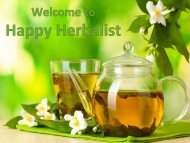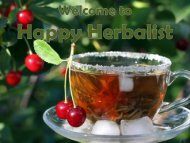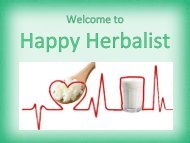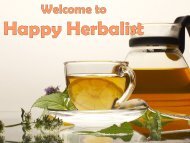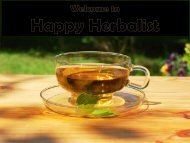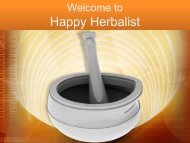Ferment Any Probiotic with Brewing Containers
Create successful ePaper yourself
Turn your PDF publications into a flip-book with our unique Google optimized e-Paper software.
Welcome to<br />
Happy Herbalist
About Us<br />
Welcome to our Functional Food website. We believe food<br />
makes our life Healthy and Happy.<br />
We nurture Kombucha, Kefir, Ginger Beer, Caspian Sea<br />
Yogurt, and other <strong>Probiotic</strong> Drinks not only for their<br />
flavors but to enhance their medicinal effects.<br />
By integrating Traditional Chinese Medicine <strong>with</strong> common<br />
Teas, Herbs & Spices <strong>with</strong> these unique Functional Foods<br />
and <strong>Probiotic</strong> drinks we believe we truly can create our<br />
own little miracles.
Caspian Sea Yogurt<br />
Caspian Sea Yogurt also goes by the name Matsoni<br />
yogurt. It contains a myriad of live cultures and is one of<br />
the few yogurts that will culture at room temperature. It's<br />
also a serial culturer; meaning you can use it continually<br />
to create new cultures.<br />
It is a mesophilic culture, meaning it thrives at a moderate<br />
temperature. Culturing in winter might mean finding a<br />
warmer part of the house. It is a slightly tart yogurt <strong>with</strong> a<br />
unique viscous consistency. As it is a yogurt you create<br />
at home it is not as thick as supermarket yogurt since it is<br />
not builked out <strong>with</strong> emulsifiers.
Caspian Sea Yogurt is grown and produced by the Happy<br />
Herbalist since 1997. Different sea yogurt like:<br />
•Caspian Sea yogurt<br />
•Milk kefir<br />
•Flora probiotic<br />
•Heating mat <strong>with</strong> digital thermostat are available at here.
Heating Mats<br />
Most <strong>Probiotic</strong> <strong>Ferment</strong>s do best in a warm temperature<br />
setting. We at Happy Herbalist recommend a temperature<br />
range from 74 F to 84 F (22-28.8 C) ,for Kombucha, Jun,<br />
Ginger Beer, Water Kefir, and Vinegar. While Villi and CSY<br />
and vegetable ferments like sauerkraut do well in the mid<br />
60's (15.5 C) While one does not need constant<br />
temperature the greater the consistency the more reliable<br />
and predicable will be your ferment. OPTIONAL digital<br />
regulator helps maintain the optimal temperature <strong>with</strong>out<br />
fear of over-heating.
We at Happy Herbalist use these<br />
heaters not just for Kombucha but for<br />
our JUN, water kefir and milk kefir<br />
grains as well, depending on how cold<br />
it is. The ideal scenario would be a<br />
heater for each ferment, but if you<br />
have a lot of them, that may not be<br />
possible. Multiple small jars or a few<br />
gallon jars can each be wrapped<br />
around the heat strips we offer, so it<br />
may be possible to have a whole slew<br />
of fermented veggies going <strong>with</strong> just<br />
one or two Kombucha heating mats.
<strong>Brewing</strong> <strong>Containers</strong><br />
All our brewing containers may be used to ferment any<br />
<strong>Probiotic</strong> - Yogurt, beer, wine, cider and vinegar. Ginger<br />
Beer, Water Crystals and Kombucha can be fermented<br />
<strong>with</strong> anything that you have in your kitchen. It really does<br />
not matter to the Kombucha SCOBY. It is, a matter of<br />
preference.
For the connoisseur of kombucha. Aluminum,<br />
and of Couse lead vessels should be avoided<br />
for one's own personal health.<br />
What matters most to the kombucha and vinegar<br />
production is the shape of the container. The larger<br />
the surface area the better. The depth does not matter. The<br />
ratio of surface to depth does not matter. What is<br />
important is that the Acetobacter bacteria have as much<br />
surface oxygen as possible. Adequate ventilation is<br />
required. Lactobacillus and yeast ferment <strong>with</strong> or <strong>with</strong>out<br />
oxygen.
All ferments give off heat, evaporation and odor.<br />
Therefore be sure not to enclose your container in too<br />
tight a space, and to leave sufficient headroom (typically 3<br />
-4 inches) from the top of the container to anything above<br />
the container such as a shelf. Evaporation may condense<br />
on the surface just above and condense back into the<br />
ferment causing contamination. Evaporation may also<br />
condense in corners and <strong>with</strong>out light, mold and mildew<br />
rapidly develops. Contrary to popular belief normal room<br />
light will not adversely affect the ferment.
Contact Us<br />
516 Alliance Circle Cary,<br />
North Carolina 27519,<br />
USA<br />
Phone Number: 919-518-3336<br />
Toll Free: 888-425-8827
Thank You<br />
&<br />
Visit Again<br />
https://www.happyherbalist.com/





